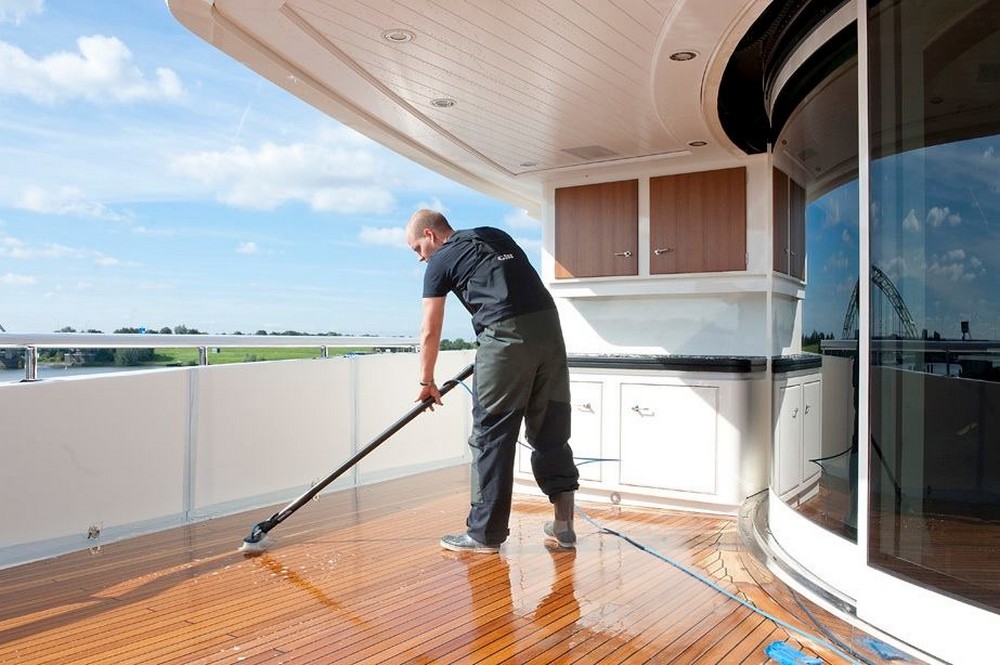
Did you ever see those old sailing adventure flicks where the British ship commander or the ranting Pirate captain gets the crew onboard to kneel and scrub the decks with fresh seawater and a ballast stone wrapped in a rag! They even had that scene in one of the 13 sequels to “Pirates of the Caribbean”. Why scrub the decks like that? Well, even if you don’t have seagull droppings, I’ll tell you anyway.
What causes most accidents and deaths on pleasure boats? Well, if you answer “Alcohol” – well that’s in contention. But even that answer is subject to certain underlying conditions. If you have a rummy on board, and you lock him in the cabin, he’s safe! Ask him to go forward and pull the hook? Well let’s just say he might end up “Slip Sliding Away”. The way pleasure boats are manufactured and how we later polish our gel coat surfaces can actually create a dangerous situation for the most ardent old salt.
Why were those old-time sailors always scrubbing those wooden decks? They did it for safety. Those wooden decks would easily get scummy and slippery if they weren’t constantly kept clean and “Roughed up” a bit. One thing you need on any boat is secure traction and for some odd reason on many pleasure boats, this is just “Glossed over”, you might say!

Aside from the fact that boats today have minimal traction surfaces because the sleek glossy look is “in”, we as boat owners tend to make matters worse. I love springtime when boats are being spruced up to return to their natural habitat-H2O. But one thing drives me nuts. The overlong wiz of the boat polisher. People get out there and go nuts polishing the hull and pilots’ station, the tops of their cabins and all the places that need to have their gel coat restored and gleaming.
But often it doesn’t end there. Wild with the enthusiasm of the large whirling buffer in hand, they attack the tops of gunnels where they and their guests step. They whiz away on built-in steps and over walkarounds which may have a slightly pebbled area for grip, but adding polish greatly reduces its effectiveness. Then, it’s on to the foredeck, where today many are designed with sloping curves to the stem and sides right to the edge where a short stylish rail is supposed to prevent you from sliding overboard as you deploy lines to dock. All around it’s a dangerous situation that you must think about because the boat designers today think more about “Euro-style” than safe footing.
So here are some ideas you may want to consider when making your boat gleam in the noon-day sun. Firstly, wherever a foot is ever possibly going to place – “clean it – don’t gleam it!” All decks and gunnel tops keep clean and don’t put polish and buff over any deck that has a slightly gritty surface supplied in manufacturing. It’s there for a reason. Let it be. Those sloping front decks just keep them clean and though I don’t support any individual products here, there are some “Non-skid waxes” out there for those questionable surfaces, though I have never used them. If you Goggle “Non-skid boat waxes and finishes” you’ll find a ton of stuff there. Your guess, your choice, not mine. When you see so many products you know there is a problem.
There are also tutorials on how to keep your non-skid surfaces looking good by buffing them to a hockey rink surface. Lately, it has become very trendy to install EVA foam teak on decks and I must admit my friend Jay did it and that it is very functional and good looking, especially on bigger boats. There are different styles and colors to suit your taste. I won’t swear to its longevity because it’s relatively new and I have my doubts about my fishy decks, but who knows?
So that’s it my fine boating friends. Keep safe and see you on the waves!
Captain Eddie.
